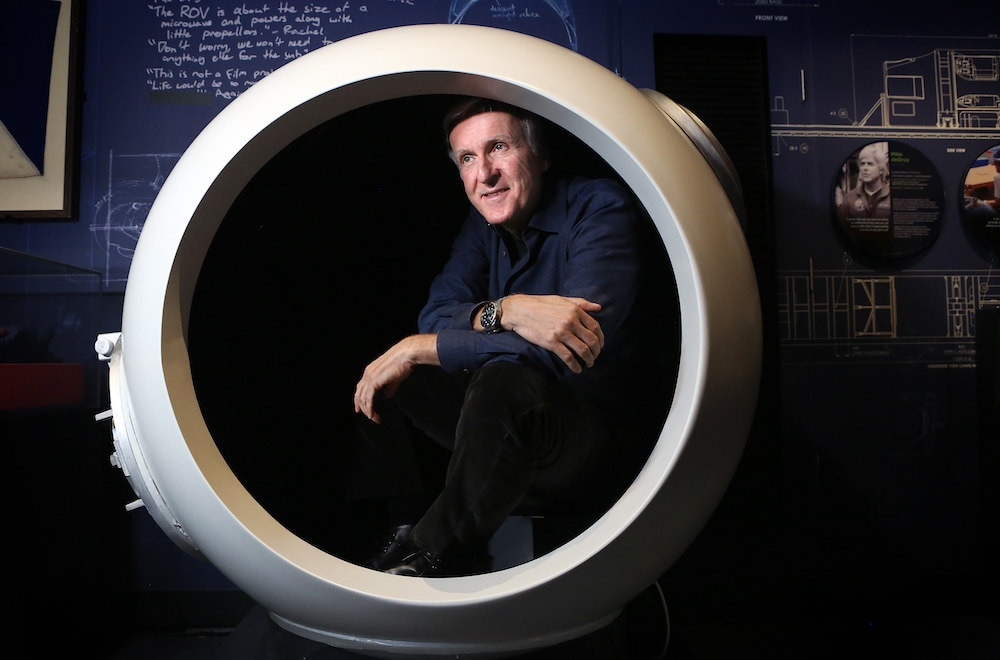Create a free profile to get unlimited access to exclusive videos, sweepstakes, and more!
Shaken by Titan Disaster, James Cameron Reflects on His Own Undersea Expeditions
James Cameron’s Deepsea Challenge documents the story of the director’s dive to the cold, dark depths of the Mariana Trench.

The tragic fate of the submersible Titan and its crew at the site of the wrecked Titanic this week has made for compelling news, as people learn more about the way that deep-sea diving vessels are designed (and the very real risks of failure). For legendary Titanic film director James Cameron, it’s a topic that’s provided lifelong fascination; one chronicled in the 2014 Deepsea Challenge documentary he executive produced (streaming here on Peacock) to commemorate his own submersible dive to the very deepest point in the world’s oceans.
Cameron’s 2012 trip to the bottom of the Mariana Trench in the Pacific Ocean was made in the Deepsea Challenger, a custom-built submersible that Cameron and his team designed and put through rigorous testing before finally setting out to explore the trench’s 35,756-foot bottom. It’s a point “so deep you could put Mount Everest on the bottom, with four Empire State Buildings stacked on top, and not even break the surface,” he explains in the documentary — a depth three times greater than that of the Titanic site where the Titan apparently imploded this week.
RELATED: James Cameron commissions actual study in hopes of settling 'Titanic' door debate once and for all
Cameron has appeared shaken by the Titan tragedy on multiple news appearances commenting on the accident. In part, that's because he’s well acquainted with some of the Titan's five victims as a member of the world’s small and closely-knit submersible community. But he’s also criticized the vessel’s carbon composite hull design, an approach he told CNN this week is “completely inappropriate for a vessel that sees external pressure.”
“We always understood that this was the wrong material for submersible hulls,” he said, “because with each pressure cycle, you can have progressive damage. So it’s quite insidious: You may have a number of successful dives, which is what happened here, and have it fail later.”
Cameron’s Deepsea Challenge documentary illustrates just how contingent and filled with risk any submersible mission can be, with Cameron and his team putting their own craft through seemingly endless rounds of computer modeling and actual test dives that themselves were frequently beset by failure. There’s “a certain healthy paranoia that goes into the engineering of a vehicle like this,” Cameron confesses in the film, with consulting team member John Garvin putting a finer point on things elsewhere in the documentary: “When you dive to the bottom of the ocean, you have to face the fact that there are a hundred horrible ways to die.”
After numerous setbacks both in the water and during the craft’s development (team members Andrew Wight and Mike deGruy were killed in a helicopter crash as the Deepsea Challenger was being built in Australia), the vessel successfully touched down at the Mariana Trench bottom on March 26, 2012. Cameron, who explored his early-career fascination with deep sea adventure in 1989’s sci-fi movie The Abyss, has of course made numerous dives since then, even as he’s divided his schedule to continue making movies with last year’s Avatar sequel Avatar: The Way of Water.
Both in fiction and in reality, Cameron’s enduring obsession with deep-sea exploration has yielded some amazing discoveries that have drawn the attention of dedicated scientists — including the discovery of dozens of previously-unknown deep ocean-dwelling species.
For an amazing (and timely) up-close look at the perils and triumphs of diving into the Earth’s last unexplored frontier, check out James Cameron’s Deepsea Challenge — narrated by Cameron himself — streaming here on Peacock.


























